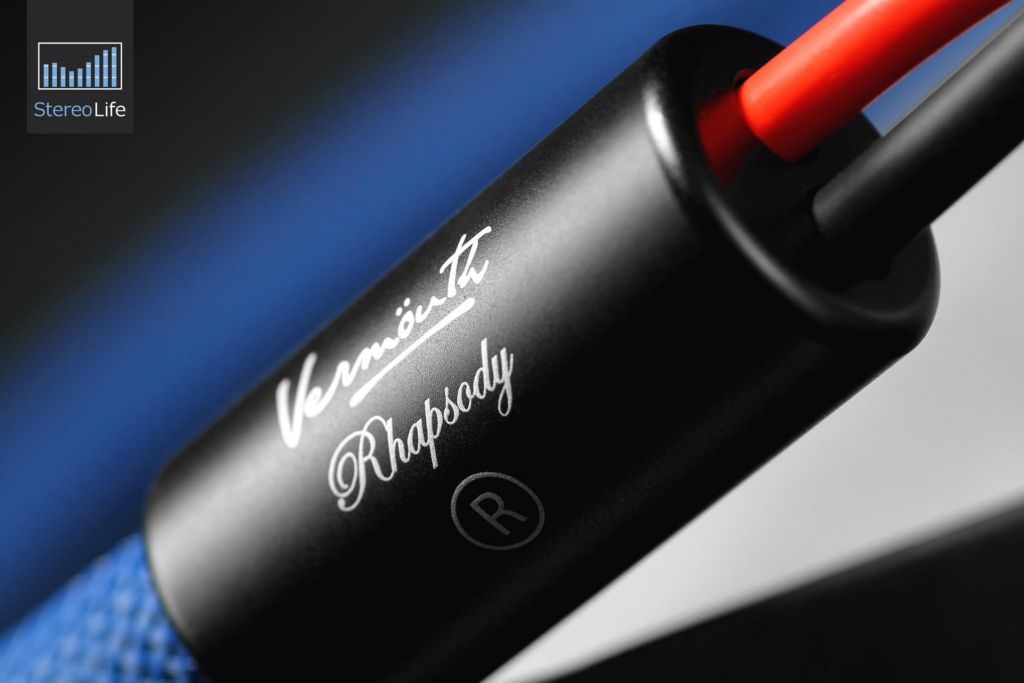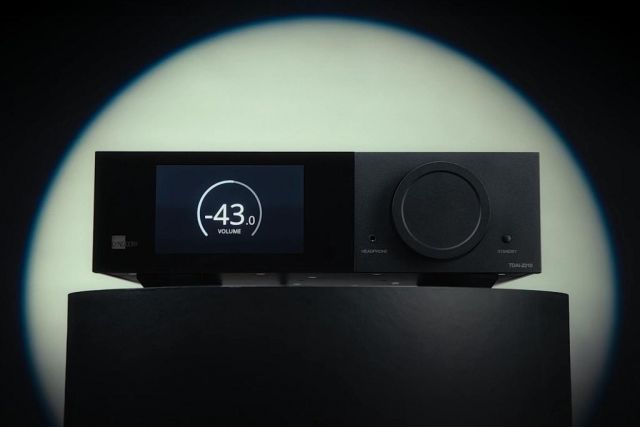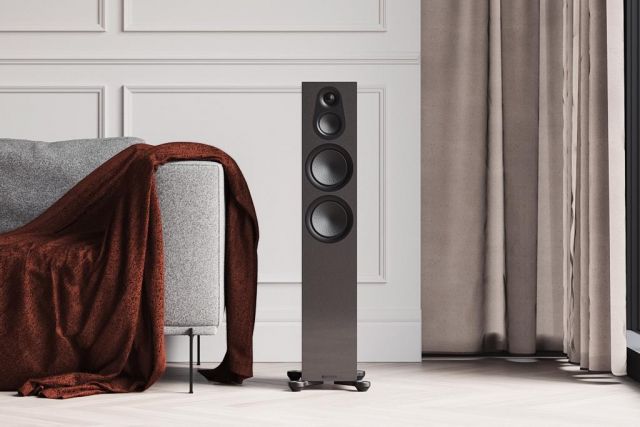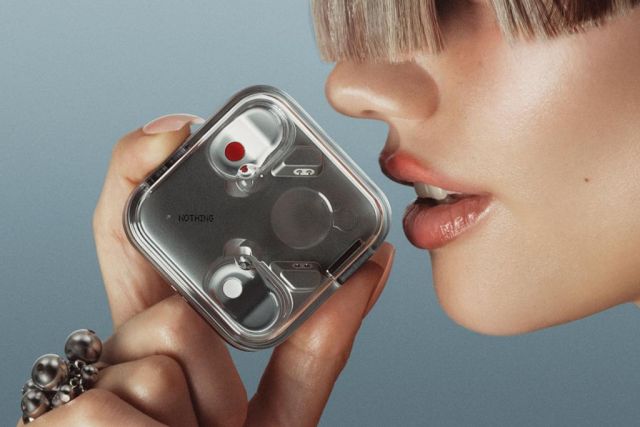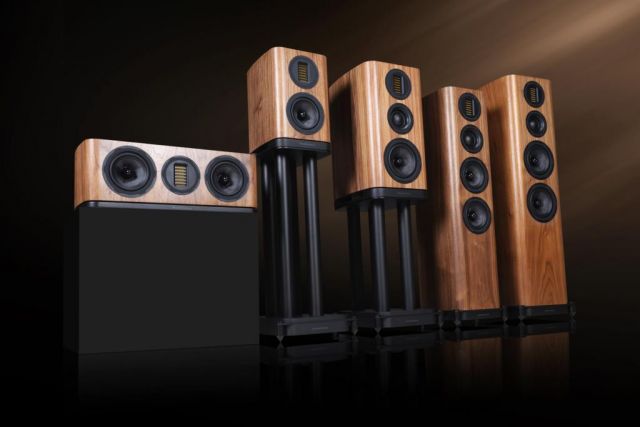
- Reviews
- Posted
Vermouth Audio Rhapsody
Designers of hi-fi equipment will never cease to amaze me with ideas for the names of their products and brands. We have already seen gear lineups inspired by celestial bodies, mythological characters, precious stones, weather phenomena, and popular drinks. I remember when a friend working in one of the showrooms told me with some disbelief that he would now sell cables called, for example, "Root Beer" or "Vodka." At first, I thought he was screwing me, but it turned out that he was earnest, and now these cables can be found in Audioquest's catalog. Hendry Ramli, the founder of Vermouth Audio, went one step further.
The man must be a great lover of this flavored wine because while I initially suspected it was some coincidence, the brand's logo dispelled any doubts. The company is based in Indonesia, more precisely in the city of Denpasar, the capital of Bali's province. It appears that Hendry Ramli is a very cunning plucker. He realized that with an original name and distinctive products, the tiny factory from an exotic island would quickly find its way into the hermetic world of hi-fi apparatus. It's good that it didn't occur to him to name his company after one of the less legal stimulants because I probably would have had to censor this review. Luckily I can assume it's safe and report on my encounter with cables from the Rhapsody line.
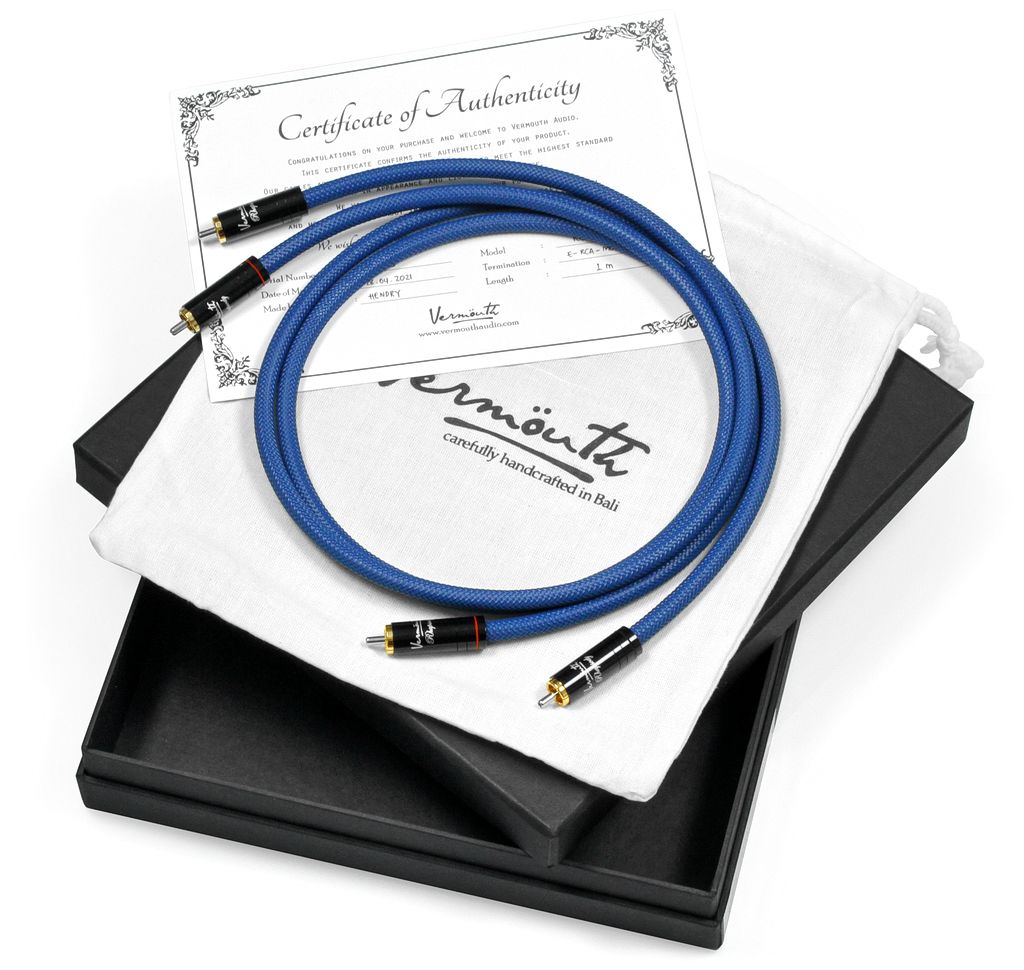
Design and functionality
Various cables and plugs make up roughly half of the Indonesian company's catalog. The other is a mix of exciting devices and accessories, such as loudspeakers, vibration absorbers, speakers (tweeter and midrange), or a highly minimalist integrated amplifier. All of this leads me to believe that the founder of Vermouth Audio is either exceptionally talented or maintains close contact with engineers and parts suppliers from Southeast Asia. I have no reason to doubt his skills, but the latter is more likely. After all, we are talking about a region that has become a holiday destination and a giant factory that supplies the world with almost everything you can name. The diverse product range doesn't affect the fact that the factory is seen as a cable specialist. It offers seven speaker cables, five analog interconnects, five power cords, one USB cable, and one phono interconnect, plus several models presumably created with manufacturers of speakers, amplifiers, and other stereo components in mind (most are meant to work as internal wiring and are only available on a spool). It's worth mentioning that Vermouth Audio imports hi-fi components and accessories to Indonesia from brands such as Accuton, Mundorf, Gold Note, Furutech, Cardas Audio, Trafomatic Audio, Jantzen Audio, and Rogoz Audio. Everything indicates that we are not dealing with an amateur project.
The Rhapsody series is one of the least expensive offerings in Vermouth's cable catalog. The 2 x 2.4-meter speaker cable costs $394, the one-meter RCA interconnect is $124, and the standard 1.5-meter power cord is $225. These are not amounts that would impress experienced audiophiles. However, I must say that the cables and packaging made an excellent impression on me. Each was packed first in a canvas bag and then in an elegant black cardboard box. Each came with a hand-signed certificate of authenticity, on which you'll find a thank-you note for your purchase, as well as information such as the serial number, date of manufacture, name of the person assembling the unit, model name, plug type, and length. Hi-end cable lovers are used to such packaging and extras (not all, as some expensive cables are sold in shabby cardboard boxes), but such attention to detail is almost unheard of in this price range. In the world of audiophile wiring, the Rhapsody series is downright budget, and the Indonesian company has put more thought into the "visual presentation of the product" than many experienced manufacturers.
The cables are protected by relatively rigid sheaths with a blue braid. The most distinctive is the speaker cable, the "main" part of which is as thick as a thumb and behaves like a pressurized garden hose, but luckily on each end, you will find 30cm flexible wires protruding from aluminum splitters. The "end cables" are secured with black and red colored sleeves, so you don't have to look for the tiny markings on the plugs during the installation. According to my information, banana plugs are the only available option. This solution is the most versatile. After unscrewing the colored bushings, it's easy to see how the bananas are mounted. It reminds me of Cardas' "monolithic" plugs, which are welded to the conductors under high pressure so that you can't see where one ends and the other begins. The power cable uses Wattgate plugs. Not very exotic, but you have to pay $29 for one of those. Since we're talking about a power cord for $225, it's hard to accuse Vermouth Audio of cost-cutting. As for looks and functionality, that would be enough. It's time to address the most important thing.
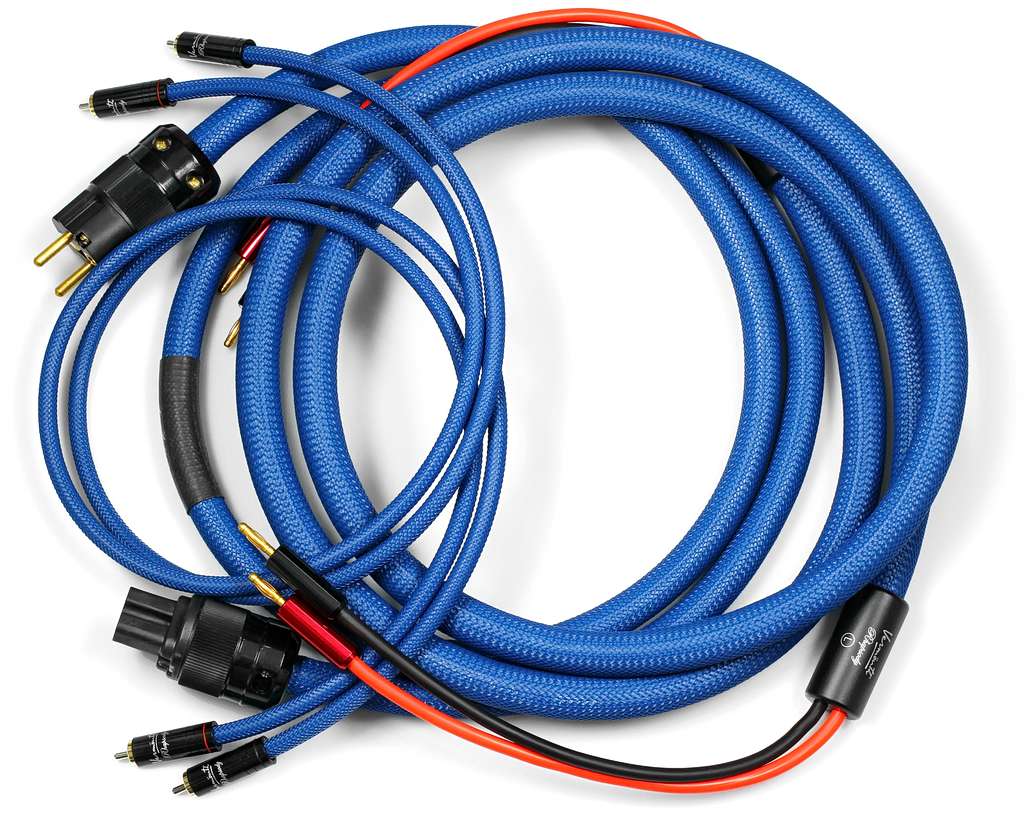
Sound performance
The world of audiophile cables has changed more in the last decade than we might think. I'm not even talking about some design details, short-term trends, the fashion for plugs covered with one metal or another, or the growing interest of the golden-eared in USB or LAN cables, but the brands that dominate the market. Until recently, depending on the country, this was a monolithic group - Audioquest, Nordost, Cardas, Kimber Kable, Siltech, Van den Hul, Fadel Art, and a few other brands. Nowadays, although most of the companies mentioned above are doing well, this lineup could be different. The list would include manufacturers such as Tellurium Q, Albedo, Chord, Hijiri, Atlas, Purist Audio Design, or Acrolink. I'm not saying that other companies have nothing to say. However, the multitude of products available on the market means that, as the Germans say, there's a lid for every pot.
I still have a great fondness for one brand whose products have disappeared from my radar - Van den Hul. They used to be one of the few wires available on the market, which on one hand offered a very high level of quality, and on the other, always spiced the sound up with something cool. What exactly? It depended on the model. Usually, a bit of warmth, but not always. Those who knew the catalog of the Dutch company and the specifics of each model very well could push the sound of any system in the desired direction. For novice stereo enthusiasts, it was like magic. One cable offered more bass and treble, the other impressed the listener with a tube-like midrange, and another did something interesting with the soundstage. However, my favorite cables from the Dutch company were those that went in the direction of gentle calmness, entering Kimber Kable's and Cardas' territory. Why do I mention this? Because after the very first listening session using Rhapsody cables, I had the impression that I had met a good old friend.
Some may think this is a bizarre theory, but every audiophile has different experiences and reference points. However, the first, utterly reflex reaction often says the most, and I felt as if Van den Hul's cables were working somewhere in my system. The sound was noticeably warm but also natural, smooth, built on a solid bass foundation, and sufficiently dynamic and resolving that the experience was not spoiled by the impression of listening to music from under a blanket. It's even possible that it wasn't due to resolution because, in this price range, we can find cables that will win over the Vermouths in this area. This was an effect partly due to the consistency and homogeneous coloring of the sound across the whole bandwidth but mainly to the surprisingly good soundstage. The combination of a mellow disposition, meaty bass, and typically "coppery" timbre with three-dimensional space is something extraordinary at this price level. Usually, you have to accept that the warmth will go hand in hand with a dimming of the treble and a certain tightness that makes it feel less like sitting in a philharmonic or standing in a stadium and more like attending a concert in a small jazz club located in a basement. On the other hand, if you use cabling to squeeze a little more air and vividness out of your equipment, the timbre will likely suffer, and the sound will become brighter, more jagged, and dry. Of course, these rules cease to apply only when we cross the financial barrier, which for most people, is the limit of insanity. But for relatively cheap cables such as these? Well, well...
Now I understand what all that hype over Vermouth Audio is all about. This sound may not be perfectly neutral, but it is very versatile in the long run. It encourages longer enjoyment of music. This is not a tool for scanning recordings. If you want to savor details, you will always find them, but they will always be presented in collaboration with the main course. They will always be an integral part of it. Except for a slight dimming of the treble and maybe a delicate "boost" of the mid-bass, there are no significant departures from neutrality here. The Indonesian cables make jazzy recordings a tad easier on the ears, and where there are dense guitar riffs, purring cello, or male vocals, suddenly, the sound is meatier. But that's where what we call adding cables' character ends. For this kind of money, it's a concise list of imperfections.
The Vermouths should fit into many hi-fi systems. This is all the better news, as fans of slightly warmer sound find it increasingly difficult to find affordable speakers and electronics. With loudspeakers, the case is still okay. You can still choose ones with a silk dome and paper or polypropylene woofers. But with an amplifier, it will be worse. "Tube-like transistors" are a dying species. The last hope is in Musical Fidelity's inexpensive integras, NuPrime's "digital" amplifiers, and a few other inventions. You can also buy a 100% tube amp, but for up to $1500, it's still a bit of a compromise. You can get a warm, calming sound for this amount, but in terms of quality, you are unlikely to be satisfied with the overall result. Vermouth's cables can solve such problems or mask them to the point where we stop thinking about them. It's even possible that they will extend the "life cycle" of the hi-fi system, pushing back the prospect of replacing speakers or electronics with something much more expensive. Is it not an excellent idea to justify one's fancies?



Build quality and technical parameters
Rhapsody is the second cheapest series of cables from Vermouth Audio. Not counting the blue protective braid, the most important common element here is UPOCC (Ultra-Pure Ohno Continuous Casting) copper, or ultra-pure monocrystalline copper. The refining process leading to its creation was developed and patented by Professor Ohno of the Chiba Institute of Technology in Japan. In conventional processing, hot molten copper is poured into a cooled mold for extrusion, resulting in a "shredded" crystalline structure. Chemically, such material may be pure, but under the microscope, it looks like a sidewalk of concrete slabs smashed by a jackhammer. In the OCC process, cooling is done separately, and the wire is pulled out very slowly, resulting in much larger crystal sizes (a single crystal can be more than 100 m long) and increased purity, which reaches 6N (99.9999%). As for the construction of the various models, in the case of the RCA interconnect, the manufacturer informs us that it's a braided Teflon-insulated cable with Al-Mylar (aluminum-mylar foil) coating and Airtube spacer tubes. In the speaker cable, we have two groups of conductors consisting of 257 intertwined strands with a total cross-section of 12 AWG. with Airtube spacers between them. The connectors are made of cold-forged copper plated with gold, their casings and caps are made of anodized aluminum, and the thick separator sleeves are also made of aluminum, but this time sandblasted and anodized. The power cable uses conductors consisting of 222 wires with a total cross-section of 11 AWG. It features Al-Mylar insulators supplemented with cotton.

System configuration
Audiovector QR5, Equilibrium Nano, Marantz HD-DAC1, Auralic Vega G1, Hegel H20, Unison Research Triode 25, Cambridge Audio CP2, Clearaudio Concept, Tellurium Q Ultra Blue, Albedo Geo, Equilibrium Pure Ultimate, Enerr One 6S DCB, Enerr Tablette 6S, Enerr Transcenda Ultra, Enerr Transcenda Ultimate.
Verdict
I am not a big fan of vermouth. I only associate this beverage with parties, after which I would wake up on the floor, wondering if I could stand up and whether or not my colleagues painted something on my face while I was sleeping. On the other hand, I can subscribe to the Vermouth Audio cables fan club. These wires look and sound like the more expensive competitors. Does this only apply to the Rhapsody series, or is it the same with the brand's higher models? I don't know that yet, but I heard it's worth checking out. The reviewed set will hit the needs of three types of customers. The first is the one who has yet to experience high-end cables and will find such cabling a real discovery. The second is the one constantly finding flaws in their stereo. Here the Vermouths will do their job - warm and smooth this and that, but not deprive the system of dynamics and soundstage. The third is an experienced audiophile, who knows what really good cables from Van den Hul, Cardas, Fadel, Acrolink, or Acoustic Zen sound like, but is also well aware of how much they cost and will decide that it's worth looking for something similar in a price range where getting such sound performance should be impossible. But is it? Now I wouldn't be so sure.
Technical data
Construction: Braided
Conductors: UPOCC (Ultra-Pure Ohno Continuous Casting) copper
Insulation: Teflon
Shielding: Al-Mylar foil
Filling: Airtube spacers, cotton (speaker cable)
Price: $124 (1m RCA interconnect), $394 (2 x 2.4m speaker cable), $225 (1,5m power cord)
Manufacturer: Vermouth Audio
Sound performance
Editor's rating
8.2Overall9Sound7Functionality9Design10Quality6Price










